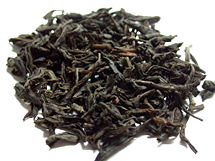Difference between revisions of "Lapsang souchong" - New World Encyclopedia
| Line 39: | Line 39: | ||
[[Image:Lapsang Souchong Tea.JPG|left|thumb|180px|Several companies market lapsang souchong tea bags]] | [[Image:Lapsang Souchong Tea.JPG|left|thumb|180px|Several companies market lapsang souchong tea bags]] | ||
Lapsang souchong from the original source is increasingly expensive, as Wuyi is a small area and there is increasing interest in this variety of tea. <ref>[http://www.inpursuitoftea.com/Lapsang_Souchong_p/bc100.htm Black Tea: Lapsang Souchong<!-- Bot generated title —>]</ref> | Lapsang souchong from the original source is increasingly expensive, as Wuyi is a small area and there is increasing interest in this variety of tea. <ref>[http://www.inpursuitoftea.com/Lapsang_Souchong_p/bc100.htm Black Tea: Lapsang Souchong<!-- Bot generated title —>]</ref> | ||
| + | Over the years this tea has suffered so many transformations and became so far removed from the original. Many tea producers would take old tea smoke it heavily and/or add chemicals with smoke flavor, and sold it as Lapsang Souchong. | ||
==Notes== | ==Notes== | ||
Revision as of 23:24, 22 January 2009

| |
| Type: | Black |
| Other names: | 正山小种 (pinyin: zhèngshān xiǎozhǒng) |
| Origin: | Mount Wuyi, Fujian Province China |
| Quick description: | Souchong smoked over pine fire, smoky taste. |
Preparation
Lapsang souchong is a black tea originally from the Wuyi region of the Chinese province of Fujian.[1] It is sometimes referred to as smoked tea. Lapsang is distinctive from all other types of tea because lapsang leaves are traditionally smoke-dried over pinewood fires, taking on a distinctive smoky flavour.[2]
History
The name in Fukienese means "smoky variety" or more correctly "smoky sub-variety." Lapsang souchong is a member of the Wuyi Bohea family of teas. The story goes that the tea was created during the Qing era when the passage of armies delayed the annual drying of the tea leaves in the Wuyi hills. Eager to satisfy demand, the tea producers sped up the drying process by having their workers dry the tea leaves over fires made from local pines.[3]
Flavor
Lapsang souchong's flavor is strong and smoky, similar to the smell of a campfire or of Latakia pipe tobacco or of ski wax. Another word to describe the taste is creosote, which should have a positive connotation. The flavor of the pine smoke is meant to complement the natural taste of the black tea, but should not overwhelm it.
Tea merchants marketing to westerners note that this variety of tea generally produces a strong reaction - with most online reviews extremely positive or strongly negative.[4]
Use
Lapsang souchong imparts a smoky flavor to oven roasted ribs even when the oven is kept at a temperature low enough to achieve a tender roast. Because of this quality, Chinese cooks smoke a variety of foodstuffs over smoldering black tea.
Its smoky flavor also may be used to add a distinctive tang to a variety of savory culinary creations. Added to mayonnaise Lapsang souchong gives an appropriate flavor for a smoked turkey sandwich[5]
Cultural significances
Regional variations
Lapsang souchong from the original source is increasingly expensive, as Wuyi is a small area and there is increasing interest in this variety of tea. [6] Over the years this tea has suffered so many transformations and became so far removed from the original. Many tea producers would take old tea smoke it heavily and/or add chemicals with smoke flavor, and sold it as Lapsang Souchong.
Notes
- ↑ Lapsang Souchong
- ↑ Stash Tea: Lapsang Souchong
- ↑ Lapsang Souchong and Other High-Fired Teas
- ↑ Lapsang Souchong Tea
- ↑ Elizabeth Knight and Bruce Richardson, Tea in the City: New York (Benjamin Press, 2006, ISBN 0966347870).
- ↑ Black Tea: Lapsang Souchong
ReferencesISBN links support NWE through referral fees
- Gautier, Lydia. 2006. Tea: Aromas and Flavors Around the World. San Francisco, CA: Chronicle Books. ISBN 978-0811856829
- Heiss, Mary Lou, and Robert J. Heiss. 2007. The Story of Tea: A Cultural History and Drinking Guide. Berkeley, CA: Ten Speed Press. ISBN 978-1580087452
- Pettigrew, Jane, and Bruce Richardson. 2008. The New Tea Companion. Perryville, KY: Benjamin Press. ISBN 978-0979343179
- Knight, Elizabeth, and Bruce Richardson. Tea in the City: New York. Benjamin Press, 2006. ISBN 0966347870
- Chow, Kit, and Ione Kramer. All the Tea in China. China Books & Periodicals Inc., 1990. ISBN 0835121941
| ||||
| Black tea | Blended and flavored teas | Chinese tea | Earl Grey tea | Green tea | Herbal tea | Lapsang souchong | Masala chai | Mate tea | Mint tea | Oolong tea | Turkish tea | White tea | Yellow tea | ||||
| Tea culture | Related to tea | |||
| China | India | Japan | Korea | Morocco | Russia | United Kingdom | United States | Samovar | Tea house | Teapot | Tea set | |||
Credits
New World Encyclopedia writers and editors rewrote and completed the Wikipedia article in accordance with New World Encyclopedia standards. This article abides by terms of the Creative Commons CC-by-sa 3.0 License (CC-by-sa), which may be used and disseminated with proper attribution. Credit is due under the terms of this license that can reference both the New World Encyclopedia contributors and the selfless volunteer contributors of the Wikimedia Foundation. To cite this article click here for a list of acceptable citing formats.The history of earlier contributions by wikipedians is accessible to researchers here:
The history of this article since it was imported to New World Encyclopedia:
Note: Some restrictions may apply to use of individual images which are separately licensed.

